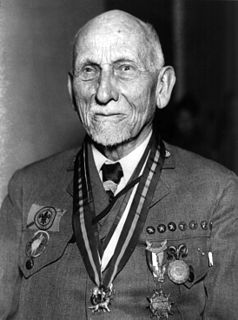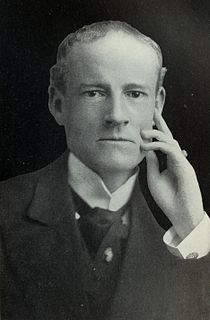
The Alaska Range is a relatively narrow, 650-km-long (400 mi) mountain range in the southcentral region of the U.S. state of Alaska, from Lake Clark at its southwest end to the White River in Canada's Yukon Territory in the southeast. The highest mountain in North America, Denali, is in the Alaska Range. It is part of the American Cordillera.

Daniel Carter "Uncle Dan" Beard was an American illustrator, author, youth leader, and social reformer who founded the Sons of Daniel Boone in 1905, which Beard later merged with the Boy Scouts of America (BSA).

Mount Hunter or Begguya is a mountain in Denali National Park in Alaska. It is approximately eight miles (13 km) south of Denali, the highest peak in North America. "Begguya" means child in the Dena'ina language. Mount Hunter is the third-highest major peak in the Alaska Range.

The name of the highest mountain in North America became a subject of dispute in 1975, when the Alaska Legislature asked the U.S. federal government to officially change its name from Mount McKinley to Denali. The mountain had been unofficially named Mount McKinley in 1896 by a gold prospector, and officially by the federal government of the United States in 1917 to commemorate William McKinley, who was President of the United States from 1897 until his assassination in 1901.

Mount Dall is a 8,399-foot (2,560 m) mountain in the Alaska Range, in Denali National Park and Preserve, southwest of Denali. Mount Dall was named in 1902 by A.H. Brooks of the U.S. Geological Survey after naturalist and Alaska explorer William Healey Dall.

Kahiltna Dome is a 12,411-foot (3,783 m) mountain in the central Alaska Range, in Denali National Park, 7.3 mi (12 km) west of Denali. It is separated from Denali by a deep glacial valley occupied by Kahiltna Glacier, with Kahiltna Pass at its head. It is described as an ice-covered dome, the 56th-highest peak in Alaska.

Mount Brooks is a mountain peak in the central Alaska Range in Denali National Park and Preserve. The 11,890-foot (3,620 m) mountain is part of a ridge extending northeastward from the main Denali massif, which includes Pyramid Peak and Mount Silverthrone. The ridge lies between Brooks Glacier and Traleika Glacier, overlooking Muldrow Glacier to the north. The summit is partly covered by ice.

Mount Capps is a 10,551-foot (3,216 m) mountain in the Alaska Range, in Denali National Park and Preserve, southwest of Denali on a ridge between Denali and Mount Crosson, close to Kahiltna Dome and at the heads of Peters Glacier and Kahiltna Glacier. Mount Capps was named in 1952 by after U.S. Geological Survey geologist Stephen Reid Capps.

Mount Carpe is a 12,552-foot (3,826 m) mountain in the Alaska Range, in Denali National Park and Preserve, on a northeast buttress of Denali. The Carpe Ridge includes Mount Tatum. Mount Carpe was named in 1943 by the U.S. Army Test Expedition after Allen Carpe, who was killed along with Theodore G. Koven, while on the Rockefeller Cosmic Ray Expedition in May 1932 when they fell into a crevasse on Muldrow Glacier.

Mount Church is a 7,621-foot (2,323 m) mountain in the Alaska Range, in Denali National Park and Preserve, overlooking Ruth Glacier.

Mount Crosson is a 12,352-foot (3,765 m) mountain in the Alaska Range, in Denali National Park and Preserve. Mount Crosson lies to the northeast of Mount Foraker, overlooking Kahiltna Glacier. The mountain was named in 1949 by mountaineer Bradford Washburn for bush pilot Joseph Crosson.

Mount Deception is a 11,539-foot (3,517 m) mountain in the Alaska Range, in Denali National Park and Preserve. Mount Deception lies 16 miles (26 km) east-southeast Denali,overlooking Brooks Glacier. The glacier-covered mountain was named by a U.S. Army crash investigation party on November 13, 1944, who were the first to ascend the mountain while investigating an airplane crash that happened in September 1944.

Mount Eldridge is a 10,082-foot (3,073 m) mountain in the Alaska Range, in Denali National Park and Preserve. Mount Eldridge lies to the northeast of Denali, overlooking Eldridge Glacier. The mountain is a large massif with several summits along a ridge. Mount Eldridge was named in 1953 by Bradford Washburn for U.S. Geological Survey explorer George H. Eldridge.

Mount Koven is a 12,142-foot (3,701 m) mountain in the Alaska Range, in Denali National Park and Preserve. Mount Eldridge lies to the northeast of Denali on Karstens Ridge, with Mount Carpe to the northeast on the Carpe Ridge extension of Denali's northeast buttress. Mount Koven overlooks the Great Icefall of Muldrow Glacier, with the west fork of Traleika Glacier to the east. It was named for Theodore G. Koven, who, while trying to rescue Allen Carpe from a crevasse in Muldrow Glacier, fell into the same crevasse and was killed while on the Rockefeller Cosmic Ray Expedition in May 1932.

Mount Mather is a 12,096-foot (3,687 m) mountain in the Alaska Range, in Denali National Park and Preserve. Mount Mather lies to the northeast of Denali, overlooking Brooks Glacier. The mountain itself is covered by glaciers. Mount Mather was named in 1947 in honor of National Park Service director Stephen Mather.

Mount Pendleton is a 7,605-foot (2,318 m) mountain in the Alaska Range, in Denali National Park and Preserve, to the east-northeast of Denali. It lies above the Polychrome Glaciers. Mount Pendleton was named in 1961 by the U.S. Geological Survey for topographer Thomas Percy Pendleton.

Mount Tatum is a 11,053-foot (3,369 m) mountain in the Alaska Range, in Denali National Park and Preserve. Mount Tatum lies to the northeast of Denali on Carpe Ridge with Muldrow Glacier to the west and Traleika Glacier to the east. Mount Tatum was named about 1945 by Bradford Washburn for Robert G. Tatum, a participant in the first ascent of Mount McKinley, reaching the South Peak on June 1, 1913.

Wedge Peak is a 9,941-foot (3,030 m) mountain in the Alaska Range, in Denali National Park and Preserve. Wedge Peak lies to the northeast of Denali overlooking Brooks Glacier and Muldrow Glacier. Mount Mather (Alaska) is immediately to the east. The peak was named in 1945 by the U.S. Army Air Force cold weather test expedition..








